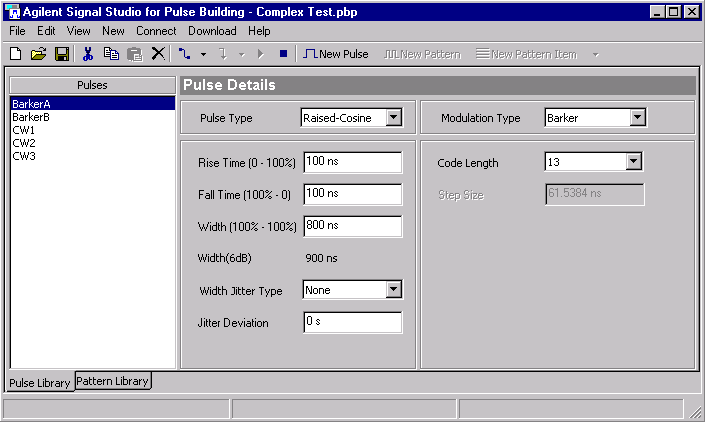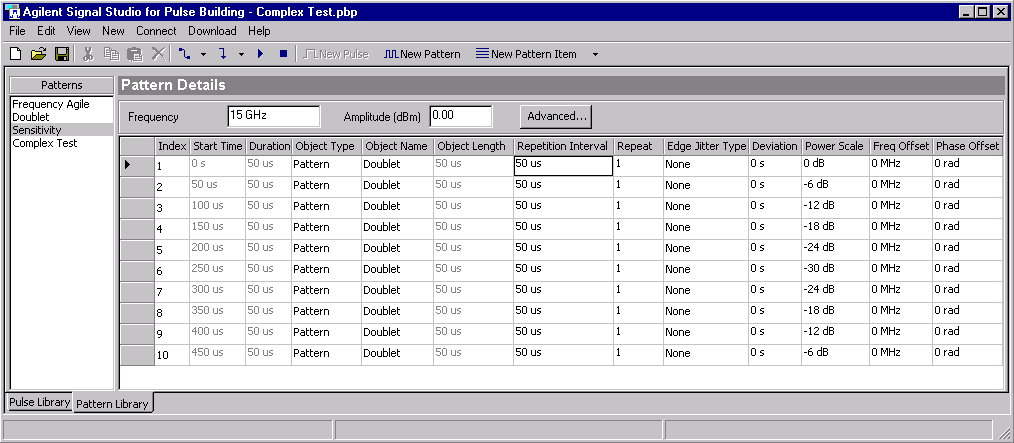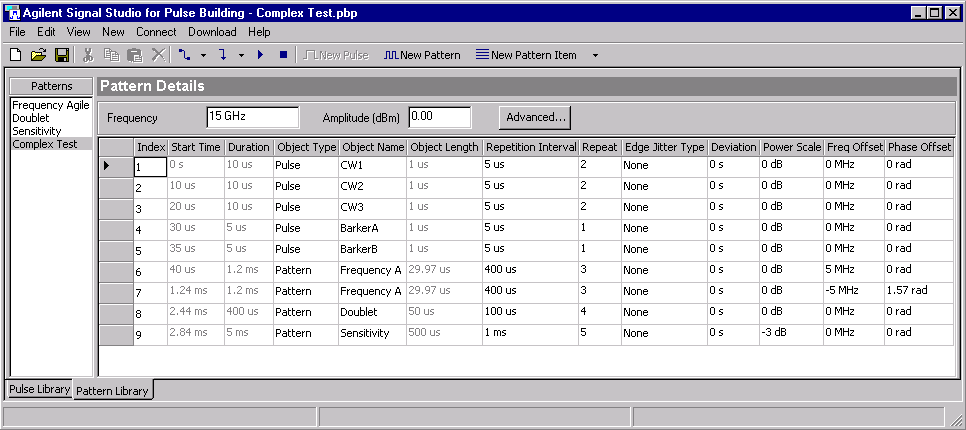Open topic with navigation
Complex Test Example
The Complex Test example demonstrates using the Pulse Building GUI to
create a signal using several pattern
item types. The pattern, from which the signal is derived, uses different
pulse types and different patterns. You will copy pulses from other pulse
building projects into the Complex Test project. This example demonstrates
how to:
-
Build a pattern of pulses
-
Build a pattern of patterns
-
Copy pulses from one pulse
building project to another Pulse Building project
-
Use the Import function for file input
-
Use pattern jitter
Creating the Pulses
The following procedure will guide you through the steps necessary to
create the pulses used in this example. The technique for copying pulses
is demonstrated in the Sensitivity
project. The same method is used when copying pulses from the Frequency Agile project.
If you have not created the Sensitivity
or Frequency Agile projects, use the same pulse parameters and patterns
described in those projects for the Complex Test project.
-
Run the Pulse Building application.
-
Save the project. Use the File
- Save As menu selection to save the project as Complex
Test.pbp
-
Run a second instance of the Pulse Building application
and then open the Sensitivity project created in the Sensitivity Example
section. We will copy the pulses from this project into the Complex Test
project.
-
Place the mouse pointer on the BarkerA
pulse in the Sensitivity project, click the right mouse button and select
Copy from the menu.
-
Place the mouse pointer on the New
Pulse 1 pulse in the Complex Test project, click the right mouse
button and select Paste from the menu selections. The BarkerA
pulse parameters are pasted into the New
Pulse 1 Pulse Details form.
-
Change the New Pulse
1 name to BarkerA. Place
the mouse pointer on New Pulse 1,
right mouse click, and select Rename.
-
Click the New Pulse button  in the Complex Test project.
in the Complex Test project.
-
Repeat steps 4 through 6 for the BarkerB
pulse.
-
Close the Sensitivity Pulse Building application.
-
Run a second instance of the Pulse Building application
and then open the Frequency Agile project created in the Frequency Agile Example section. We will copy
the pulses in this project into the Complex Test project.
-
Copy the CW1,
CW2, and CW3
pulses in the Frequency Agile project and paste them into the Complex
Test project. Use the technique outlined in steps 4 through 6 to copy
the pulses from one project to another.
The Pulse Library form below shows the pulses used in the Complex Test
project.

Creating the Pattern
There are now five pulses
BarkerA, BarkerB,
CW1, CW2,
and CW3 stored in the Complex
Test Pulse Library. This section details the steps needed to create the
patterns using these pulses.
-
Click the
Pattern Library tab at the lower left corner of the Pulse Library form.
-
Click the
 icon.
icon.
-
Rename New Pattern
1 to Frequency Agile.
-
Click
the mouse pointer on New Pattern 1 in
the patterns section of the form
-
Click
the right mouse button
-
Select
Rename from the menu and type in Frequency Agile
-
Run a second instance of the Pulse Building application
and then open the Frequency Agile project
-
Copy the Frequency Agile
pattern from the Frequency Agile Example project.
-
Click the mouse pointer on the Frequency Agile pattern
in the Frequency Agile Example project then click the right mouse button
and select Copy.
-
Click the mouse pointer on the Frequency Agile pattern
in the Complex Test pattern then click the right mouse button and select
Paste.
-
Close the Frequency Agile Pulse Building application.
The Complex Test project
now has the Frequency Agile pattern in its Pattern Library. There are
two other patterns that need to be copied into the project: the Doublet and Sensitivity
patterns from the Sensitivity Example project. The Pulse Building application
cannot copy patterns of patterns. So the Scan
pattern will need to be created in the Complex Test project.
-
Click the
 icon in the Complex Test project
icon in the Complex Test project
-
Rename New Pattern 1 to Doublet:
-
Click
New Pattern 1 in the Patterns
section of the form
-
Click
the right mouse button
-
Select
Rename from the menu and type in Doublet
-
Run a second instance of the Pulse Building application
and then open the Sensitivity project and copy the Doublet
pattern:
-
Place the mouse pointer on the Doublet
pattern in the Sensitivity Example project, click the right mouse button,
and select Copy.
-
Place the mouse pointer on the Doublet
pattern in the Complex Test pattern, click the right mouse button, and
select Paste.
-
Click the  icon in the Complex Test project
icon in the Complex Test project
-
Rename the New Pattern 1 to Sensitivity.
-
Copy
the pattern parameters from the Pattern Details section of the form shown
below and use them in the Complex Test pattern.

-
Index 1
- 10: Object Type: Pattern, Object Name: Doublet, Repetition Interval:
50 us, Repeat: 1, Edge Jitter Type: No Jitter, Power Scale: Use the data from the form above.
The
last pattern to create, Complex Test, uses a combination of patterns,
patterns within a pattern, and pulses. This section
details the steps needed to create this pattern.
-
Click the
 icon.
icon.
-
Rename New Pattern 1 to Complex
Test:
-
Place
the mouse pointer on New Pattern 1 in
the patterns section of the form
-
Click
the right mouse button, select Rename and type in Complex Text
-
Add pattern
items to the Complex pattern. Click the  icon nine times.
icon nine times.
-
Click the
mouse pointer in the cell located at Index 1 and Object Name.
-
Select CW1
from the pull-down menu selections.
-
Click the
mouse pointer in the cell located at Index 1 and Repetition Interval.
Enter 5 us in this cell
-
Copy the
pattern parameters for the Complex Test pattern from the pattern details
form shown below.

Download and Play
-
Click the
Connect
to Instrument button  .
.
-
Enter TCP/IP
or GPIB interface parameters for the instrument in the System Configuration
wizard.
-
Click the
Test I/O command button. The Status text box in the I/O Connection form
should display: Connected
If errors or a timeout occurs refer to the troubleshooting section
in the Help documentation.
-
Click OK.
If you do not have a spectrum/signal analyzer,
you must disable the Auto-Correction routine. Go to and remove the check mark from the Auto-Correction
check box.
If you are using a spectrum/signal
analyzer, perform the following steps:
-
Click the
Connect
to Instrument button  .
.
-
Enter TCP/IP
or GPIB interface parameters for the instrument in the System Configuration
wizard.
-
Click the
Test I/Ocommand button. The Status
text box in the I/O Connection form should display: Connected
If an error or a timeout occurs, refer to the troubleshooting section
in this Help document or VISA documentation.
-
Click OK.
Click the Download menu item at the top of the form
and select Download
& Play. The lower section of the form, labeled VerifySignal Result: indicates the result of the
signal creation and download process.
At this point the signal
is loaded in the signal generator's volatile waveform memory and the signal
generator is playing the signal. You can use the analyzer to view this
signal. Use the following analyzer settings:
You can save this waveform
file in the signal generator's non-volatile waveform memory. When you
save the waveform file, instrument state parameters configured in the
Advanced settings section such as frequency and amplitude are not included.
Use the signal generator's Save/Recall
registers to save the signal generator's instrument state. When you want
to re-load the signal and play it back:
-
Load the
signal into volatile waveform memory.
-
Recall the
register with the signal generator's instrument state associated with
the waveform file.
A signal downloaded to the signal generator's
memory has a sequence file associated with it. These sequence files are
loaded into the signal generator's non-volatile memory and will remain
in memory until manually removed. The Pulse Building application does
not remove unused sequence files.
If you delete a waveform file, delete the associated non-volatile
sequence file. Unused sequence files can consume signal generator memory.
Related Topics
Complex Test API Program Example
 in the Complex Test project.
in the Complex Test project.


 .
.